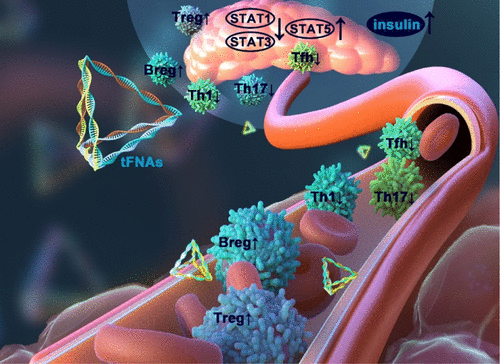当前位置:
X-MOL 学术
›
ACS Appl. Mater. Interfaces
›
论文详情
Our official English website, www.x-mol.net, welcomes your
feedback! (Note: you will need to create a separate account there.)
Tetrahedral Framework Nucleic Acids Reverse New-Onset Type 1 Diabetes
ACS Applied Materials & Interfaces ( IF 8.3 ) Pub Date : 2021-10-19 , DOI: 10.1021/acsami.1c16151 Shaojingya Gao 1 , Mi Zhou 1 , Yanjing Li 1 , Dexuan Xiao 1 , Yun Wang 1 , Yangxue Yao 1 , Yang Gao 1 , Xiaoxiao Cai 1 , Yunfeng Lin 1, 2
ACS Applied Materials & Interfaces ( IF 8.3 ) Pub Date : 2021-10-19 , DOI: 10.1021/acsami.1c16151 Shaojingya Gao 1 , Mi Zhou 1 , Yanjing Li 1 , Dexuan Xiao 1 , Yun Wang 1 , Yangxue Yao 1 , Yang Gao 1 , Xiaoxiao Cai 1 , Yunfeng Lin 1, 2
Affiliation

|
Type 1 diabetes (T1D) is caused by breakdowns of central and peripheral immune tolerance and destructions of insulin-producing β-cells. Conventional insulin injection cannot cure the disease. Regulatory immune cells, including regulatory T-cells (Tregs) and regulatory B-cells (Bregs), play critical roles in immune tolerance. Inducing regulatory immune cells to halt the progress of T1D and restore immune tolerance is the promising approach in T1D immunotherapy. Here, tetrahedral framework nucleic acids (tFNAs) were utilized to treat T1D in non-obese diabetic (NOD) mice. 250 nM tFNA treatment was adopted in the experiment to reverse hyperglycemia and protect insulin-secreting β-cells in diabetic NOD mice. In addition, 250 nM tFNA treatment could induce Tregs and Bregs and suppress helper T (Th)-cells in the pancreas. In the pancreas, cytokines, as a significant signal during CD4+ T-cell differentiation, directly direct the differentiation programs. Apart from cytokines directing the differentiation of T-cells, the signal transducer and activator of transcription (STAT) signal is strongly associated with T-cell differentiation and T1D progression. We demonstrated tFNA treatment inducing regulatory immune cells probably by increasing TGF-β levels and the STAT signal. To sum up, 250 nM tFNA treatment could protect the diabetic NOD mice from hyperglycemia and preserve the functions of β-cells by restoring peripheral immune tolerance. The possible mechanism of inducing immune tolerance was related to the STAT signal and cytokine changes in the pancreas. Moreover, immunoregulation capabilities of tFNAs were demonstrated in the experiment, which set the foundation of tFNAs participating in further antigen-specific immunotherapies.
中文翻译:

四面体骨架核酸逆转新发 1 型糖尿病
1 型糖尿病 (T1D) 是由中枢和外周免疫耐受的破坏以及产生胰岛素的 β 细胞的破坏引起的。常规的胰岛素注射不能治愈这种疾病。调节性免疫细胞,包括调节性 T 细胞 (Tregs) 和调节性 B 细胞 (Bregs),在免疫耐受中起关键作用。诱导调节性免疫细胞阻止 T1D 的进展并恢复免疫耐受是 T1D 免疫治疗的有希望的方法。在这里,四面体框架核酸 (tFNA) 用于治疗非肥胖糖尿病 (NOD) 小鼠的 T1D。实验中采用 250 nM tFNA 治疗来逆转糖尿病 NOD 小鼠的高血糖并保护分泌胰岛素的 β 细胞。此外,250 nM tFNA 处理可诱导 Tregs 和 Bregs 并抑制胰腺中的辅助 T (Th) 细胞。在胰腺中,细胞因子,+T细胞分化,直接指导分化程序。除了指导 T 细胞分化的细胞因子外,信号转导和转录激活因子 (STAT) 信号与 T 细胞分化和 T1D 进展密切相关。我们证明了 tFNA 治疗可能通过增加 TGF-β 水平和 STAT 信号来诱导调节性免疫细胞。综上所述,250 nM tFNA 治疗可以保护糖尿病 NOD 小鼠免受高血糖,并通过恢复外周免疫耐受来保护 β 细胞的功能。诱导免疫耐受的可能机制与胰腺内 STAT 信号和细胞因子变化有关。此外,实验证明了 tFNA 的免疫调节能力,
更新日期:2021-11-03
中文翻译:

四面体骨架核酸逆转新发 1 型糖尿病
1 型糖尿病 (T1D) 是由中枢和外周免疫耐受的破坏以及产生胰岛素的 β 细胞的破坏引起的。常规的胰岛素注射不能治愈这种疾病。调节性免疫细胞,包括调节性 T 细胞 (Tregs) 和调节性 B 细胞 (Bregs),在免疫耐受中起关键作用。诱导调节性免疫细胞阻止 T1D 的进展并恢复免疫耐受是 T1D 免疫治疗的有希望的方法。在这里,四面体框架核酸 (tFNA) 用于治疗非肥胖糖尿病 (NOD) 小鼠的 T1D。实验中采用 250 nM tFNA 治疗来逆转糖尿病 NOD 小鼠的高血糖并保护分泌胰岛素的 β 细胞。此外,250 nM tFNA 处理可诱导 Tregs 和 Bregs 并抑制胰腺中的辅助 T (Th) 细胞。在胰腺中,细胞因子,+T细胞分化,直接指导分化程序。除了指导 T 细胞分化的细胞因子外,信号转导和转录激活因子 (STAT) 信号与 T 细胞分化和 T1D 进展密切相关。我们证明了 tFNA 治疗可能通过增加 TGF-β 水平和 STAT 信号来诱导调节性免疫细胞。综上所述,250 nM tFNA 治疗可以保护糖尿病 NOD 小鼠免受高血糖,并通过恢复外周免疫耐受来保护 β 细胞的功能。诱导免疫耐受的可能机制与胰腺内 STAT 信号和细胞因子变化有关。此外,实验证明了 tFNA 的免疫调节能力,































 京公网安备 11010802027423号
京公网安备 11010802027423号